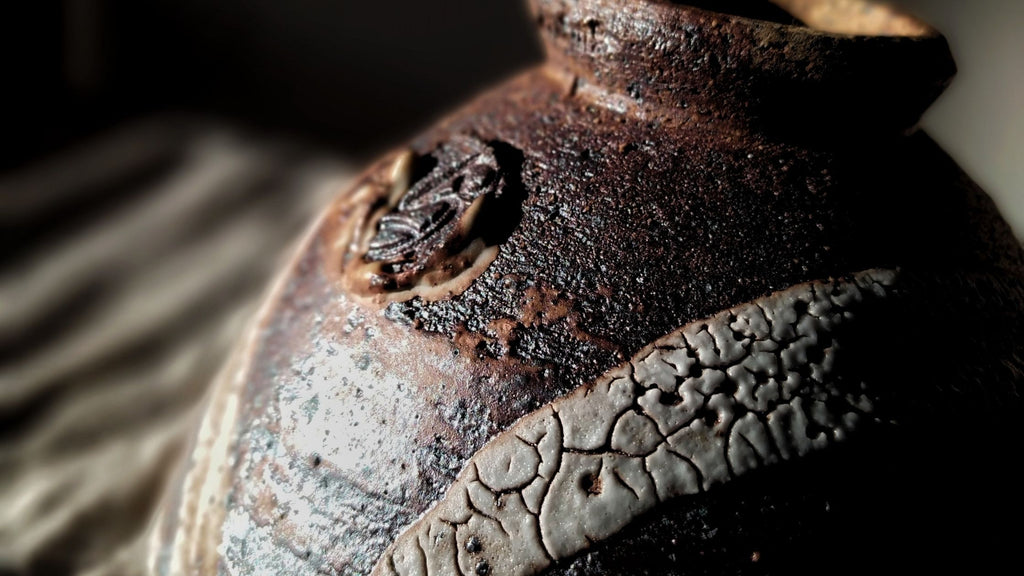Texture in ceramics

There's something about texture in ceramics that is simply irresistible. Like beauty, texture brings depth to a piece. It reaches beyond functionality to dig deep in our sensory experience. A mere useful teapot becomes your favourite when you have pleasure holding it and using it. Because ceramic is such a tactile medium (and teaware especially), the feeling and visual appeal of a piece’s surface always ends up playing a major role in our appreciation.
For texture helps bridge the gap between your mind and the object lying on the table. When a pot touches your finger or rests in your palms, it pulls your attention to its contact, to the sensory experience unfolding in your hands. Although two teacups can have the same function, they nonetheless provide different experiences. Texture, in a way, highlights the unicity of each moment.
There are different angles to approach texture in ceramics.

One of them has to do directly with clay composition. Depending on their mineral content, different clays will naturally present different textures before and after firing. Porcelain, for example, which is mostly made of kaolinite clay, fires at higher temperatures and results in smoother, harder, and more vitrified surfaces than stoneware clay. Mixing clays (or clay-types) or adding materials to their composition is a good way to work around texture.
The same goes with how the clay is shaped to form the body of a piece. As we tend to think of the different making techniques in terms of the volumes they allow potters to make, we must also remember that they ultimately produce different surfaces. Throwing pieces on the potter’s wheel not only allows for making consistent shapes like spheres and cylinders, but it also results in usually smoother and more even surfaces than, let’s say, handbuilt pots.

Repeatedly pinched and pressed in the hand, handbuilt ceramics keep marks on their surface of the story of their becoming. Shape becomes texture, texture becomes pattern. Holding it, you can retrace the object moving from a generic lump of clay to a finished, fired form.

Makiko works on texture by carving her cups with a blade after they’ve been thrown on to achieve a more dynamic surface. The continuity of the wheel-thrown shape is broken in myriads of little flat areas and discrete edges, with her glazes playfully running across everything to create a quiet sense of pattern.

Another way to create texture
is by adding different materials, or layers of materials, on top of a pot’s surface prior to firing. Enamels (silica-based – also called glazes) and slips (clay-based) are commonly used to dress pots in their final colors and shines. Again, mixing and adding elements to these recipes has a tremendous impact on their final esthetics. Both enamels and slips being applied to pots before they are fired means they are, thereof, usually measured in both their composition and application. Consequentially, this leads to more controlled results.

For an extra dose of risk and excitement, some potters prefer their pots to be decorated during firing. In other words, they add their materials directly into the kiln’s chamber and let the fire do the work. Gas firing and wood firing tend to be particularly well-suited for this type of decoration. Wood firing, of course, because the kiln needs to be opened regularly anyway to be stoked and fueled (providing the opportunity to throw coals or salt into the chamber), and gas firing because the intense heat produced by the flame allows vaporizing materials mid-air and letting them randomly stick somewhere else (salt here is most commonly used, sometimes with soda).

The case of wood firing deserves a few extra words because continuously stoking the kiln with burning wood for several hours (or days) produces a lot of residues. Ashes, notably. The kiln being fired up by tossing logs through different openings around the chamber several times an hour means there is no way to keep the extremely hot ashes from flying around and melt on surfaces where they later harden. Smoke evacuating from the chimney above the kiln pulls a draft through the chamber which carries the ashes around. By knowing how a kiln’s design influences drafts and heat distribution inside the chambers, experienced potters can hopefully predict, at least in some way, where and how the ashes will impact the pieces. But everything here is ultimately left to the flames’ will. Under such conditions, not all pots are created equal. Some come out of the firing good, some very good, some broken by logs being pushed too far into the chamber, some fused to their shelves by much-melted ashes and here and there, a few gems emerge that makes this trouble worthwhile.

Leave a comment